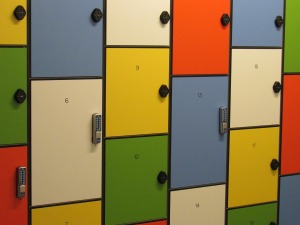[Preamble: A reader asked if I was claiming, in this post, to have Dissociative Identity Disorder (DID), and so I wanted to clarify what I am trying to describe, and make it clear that I am not here talking about DID. As I understand it, in DID the ‘parts’ switch in and out and aren’t aware of each other at the time, and to a large extent have their own memories as well. Whereas my ‘parts’ are simply the roles and different ways of relating that I tend to fall into – some are more childlike, and some more parental, for example. But I’m aware of them all and as far as I retain memories (which is an issue for me generally) they are all ‘my’ memories, covering all experience irrespective of what role I feel I’m in, and when I speak in this post about locking things away, I am talking about suppressing feelings rather than ‘switching’. I feel conscious when I am talking about ‘parts’ that I am to some extent trespassing on the language of DID – however, I think that it can be a helpful language and way of thinking about aspects of oneself in general, and I am hoping I won’t confuse or offend by using it!]
It has been useful for me recently, to be able to think of the different aspects of myself as semi-distinct ‘parts’, and I drew a picture of these in a recent post. Bearing them in mind has helped me to more easily identify when I am slipping into particular ‘roles’ or ways of being, and to try and stay on top of and in control of, the various thoughts and emotions that accompany them. It has also helped me to try and figure out ways of soothing or helping myself, depending on which ‘part’ is most at the fore.
However, I have started to wonder whether I am beginning to misuse the concept – as with most things, there can be less helpful applications in addition to the valuable ones. Last weekend I felt as though I was hovering above my feelings; for example, I was aware of at least three different emotions in response to my therapist’s offer of an additional session this week, but I wasn’t really feeling any of them. I felt like an observer of, rather than a participant in, my own reactions. And when my therapist asked me a few days ago how I had been feeling over the weekend, I found I couldn’t really answer the question.
 That experience may have been a response to my intense sessions last week, when I was describing past distressing events in which I had dissociated and felt as though I was observing myself. Perhaps my sense over the weekend of being a ‘watcher’ of my feelings, was a mild re-creation of that experience. On the other hand, I have also noticed a tendency recently to use my ‘parts’ as a sort of ‘dumping ground’ for my feelings – somewhere to put them to ‘get rid of them’. Or, thinking of it another way, I have come to visualise my ‘parts’ as lockers – places where I can shut things away that I consider ‘bad’ and undesirable. This is particularly true of aspects associated with the part I call ‘the stroppy one’, and feelings and behaviours that remind me of the ‘teenage me’. These are the aspects described in recent posts such as ‘Addicted to feeling torn’ and ‘A tale of three houses: therapy, progress and internal conflict’ – self-destructive, relationship-destructive, looking for a fight. I am starting to get a handle on how to deal with the ‘inner child’ part of me, but I haven’t got a clue about how to reach the slightly older version of that child. And so it has felt much easier to simply pick up on her presence, think ‘oh, that’s not good’ and then mentally compartmentalise her experience and try and shut it away.
That experience may have been a response to my intense sessions last week, when I was describing past distressing events in which I had dissociated and felt as though I was observing myself. Perhaps my sense over the weekend of being a ‘watcher’ of my feelings, was a mild re-creation of that experience. On the other hand, I have also noticed a tendency recently to use my ‘parts’ as a sort of ‘dumping ground’ for my feelings – somewhere to put them to ‘get rid of them’. Or, thinking of it another way, I have come to visualise my ‘parts’ as lockers – places where I can shut things away that I consider ‘bad’ and undesirable. This is particularly true of aspects associated with the part I call ‘the stroppy one’, and feelings and behaviours that remind me of the ‘teenage me’. These are the aspects described in recent posts such as ‘Addicted to feeling torn’ and ‘A tale of three houses: therapy, progress and internal conflict’ – self-destructive, relationship-destructive, looking for a fight. I am starting to get a handle on how to deal with the ‘inner child’ part of me, but I haven’t got a clue about how to reach the slightly older version of that child. And so it has felt much easier to simply pick up on her presence, think ‘oh, that’s not good’ and then mentally compartmentalise her experience and try and shut it away.
 My therapist encouraged me to think of the parts as filing cabinet drawers rather than lockers – not somewhere to shut feelings away, but a way of identifying where they might belong, where they have come from and what they might be linked with. I think that is helpful, but I’m still struggling to find a middle ground between becoming immersed in all my emotions, whether positive or negative, and maintaining a healthy perspective without cutting myself off from them. I didn’t like that sense of ‘hovering over’ my feelings during the weekend – it felt far too remote.
My therapist encouraged me to think of the parts as filing cabinet drawers rather than lockers – not somewhere to shut feelings away, but a way of identifying where they might belong, where they have come from and what they might be linked with. I think that is helpful, but I’m still struggling to find a middle ground between becoming immersed in all my emotions, whether positive or negative, and maintaining a healthy perspective without cutting myself off from them. I didn’t like that sense of ‘hovering over’ my feelings during the weekend – it felt far too remote.
As well as feeling ‘cut off’, another difficulty of trying to lock parts away, is of course the fact that it doesn’t really work. The parts are still persistently there, and it takes mental energy to actually keep the lockers locked. While that energy is slowly being drained, the parts themselves are growing in their clamour to be heard, and they become more easily triggered and harder to ignore. A couple of days ago I went into therapy feeling a little like the person on the left, and came out feeling a lot like the person on the right:
It wasn’t just my ability to keep ‘the stroppy one’ from taking over that seemed to have vanished, but my desire to do so as well. Although some part of me really didn’t want to feel that bad, other aspects were colluding to persuade me that it was pointless to resist the angry and self-destructive feelings, and that giving in to ‘her’ would be a welcome relief.
Perhaps if I had tried to consistently ‘file’ her rather than ‘dump’ her, I may have been more successful in terms of staying in control; though I suspect she is almost as resistant to categorisation as she is to segregation! But I have been trying to keep her away from my therapist, fearing the wrecking power that she has over the relationship, and perhaps that was a mistake. Things always have more power when not talked about, and therapy should be the place where anything can be brought out into the light.
I will continue to try and understand the various parts of me, and allow myself to experience them rather than trying to identify but then ignore them. In the meantime, if anyone has any suggestions on how to get through to a stroppy teenager and help her feel better, they would be very welcome!



June 22, 2016 at 10:06 pm
Are you saying you have dissociative identity disorder?
LikeLiked by 1 person
June 22, 2016 at 10:35 pm
No, definitely not, and thank you for giving me the opportunity to clarify! I may try and amend post wording to make that clearer. .. as I understand it, in DID the parts switch in and out and aren’t aware of each other at the time, and to a large extent have their own memories as well. Whereas my ‘parts’ are simply the roles and different ways of relating I tend to fall into – some are more childlike, some more parental etc. But But I’m aware of them all and as far as I retain memories (which is a bit of an issue for me generally) they are all ‘my’ memories, covering all experience irrespective of what role I feel I’m in…..when I was talking about locking things away, it was about suppressing feelings rather than ‘switching’….I hope that has clarified and apologies for the confusion !
LikeLike
June 22, 2016 at 10:37 pm
Yes, that makes things much clearer.
LikeLiked by 1 person
June 23, 2016 at 1:32 am
As far as I understand it, you don’t have to have DID to have parts. Everyone compartmentalises to an extent and it’s all on a continuum start from the normal level of being being “work” you, friend you, wife you etc…. right through to D.I.D. And I think having dissociations, fragmentation, and parts on varying levels is more common than people think especially for people with trauma histories.So if the analogy of parts helps you make sense of your experience, I think that’s okay.
LikeLiked by 1 person
June 23, 2016 at 5:33 am
Reblogged this on MAKE BPD STIGMA-FREE!.
LikeLike
June 25, 2016 at 9:03 pm
Thank you so much for the reblog!
LikeLike
June 25, 2016 at 10:55 pm
You’re very welcome!
LikeLike
June 25, 2016 at 11:16 pm
Your understanding of DID is accurate and well expressed. Sirena is also correct with regard to the fact that dissociative experiences aren’t unknown to those without DID. For example, and athlete or musician who is so preoccupied and focused on his interaction with the other players that he loses awareness of the crowd who are attending the event. The word “parts” connotes some sort of genuine distinctiveness and separation (at least to me), which might account for the confusion experienced by readers. Your use of this word in understanding yourself sounds more akin to “roles” or “mood states” or the various identities that we take on in life: mom, employee, daughter, etc.
LikeLiked by 1 person
Pingback: The power of personas | Life in a Bind - BPD and me